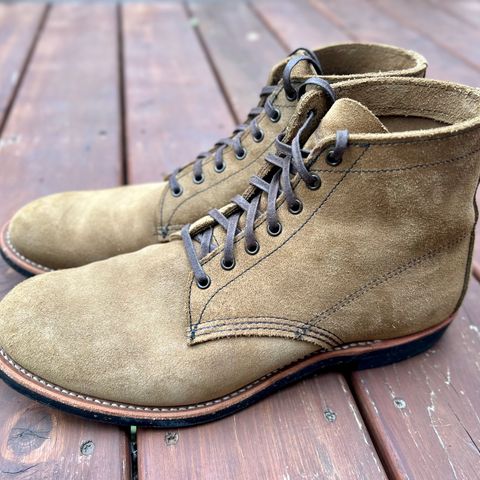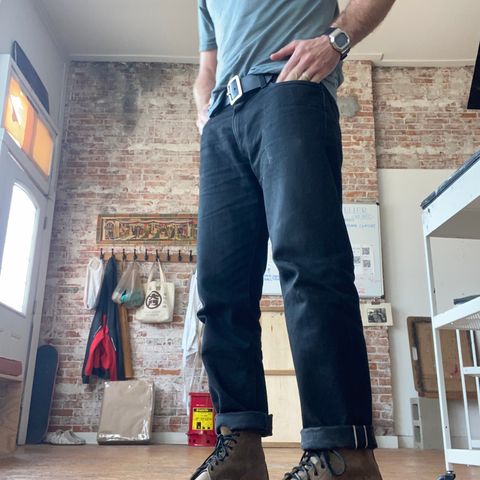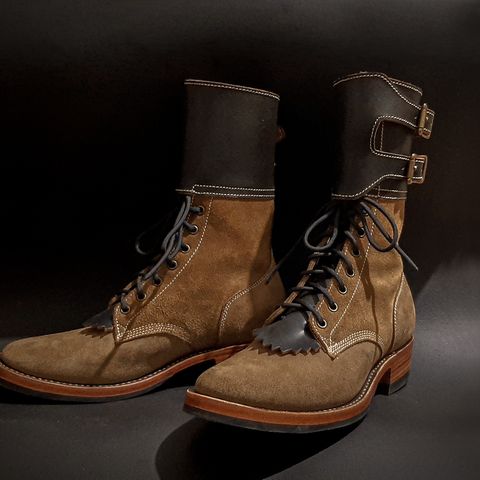About
S.B. Foot Mesa is a full-grain oil-tanned leather produced by S.B. Foot Tanning Company in Red Wing, Minnesota. The leather features a chrome-tanned base combined with oil and wax conditioning, creating a water-resistant material with distinctive pull-up characteristics. Mesa is available in multiple color variations including Red Oak and Oxblood, and is used primarily in heritage footwear applications including Red Wing Heritage boots such as the Iron Ranger and Classic Moc Toe models.
About
S.B. Foot Mesa is a full-grain oil-tanned leather produced by S.B. Foot Tanning Company in Red Wing, Minnesota. The leather features a chrome-tanned base combined with oil and wax conditioning, creating a water-resistant material with distinctive pull-up characteristics. Mesa is available in multiple color variations including Red Oak and Oxblood, and is used primarily in heritage footwear applications including Red Wing Heritage boots such as the Iron Ranger and Classic Moc Toe models.
As part of S.B. Foot's oil-tanned leather collection, Mesa undergoes the tannery's traditional wooden drum processing where steerhides soak in tree oils, tanning agents, and dyes for 14 to 20 hours. The resulting leather exhibits a semi-aniline finish with a smooth, slightly waxy texture and consistent matte appearance. The higher oil content provides weather resistance but may cause color transfer during initial wear.
Specifications and characteristics
Mesa leather is produced from full-grain steerhides in weights ranging from 5 to 6 ounces (2.0 to 2.4 millimeters), with a medium temper suitable for footwear construction. The leather receives a semi-aniline finish that allows natural grain patterns to remain visible while providing modest surface protection. As a second-run grade leather, Mesa may exhibit minor cosmetic imperfections including small scars, brands, or scratches that do not affect structural integrity.
The chrome-tanned base provides dimensional stability and flexibility, while subsequent oil and wax conditioning creates the leather's characteristic feel and performance. This combination tanning approach results in leather that resists water, stains, and perspiration more effectively than purely vegetable-tanned alternatives. The oil and wax blend penetrates the leather fibers during drum processing, producing rich color depth and enabling pull-up effects where the leather visibly lightens when bent or stretched.
Mesa exhibits a smooth surface with minimal texture variation and a slightly waxy hand feel. The matte finish shows minor pull-up characteristics, with color changes most apparent in areas of flex and wear. The higher oil content that contributes to weather resistance may also cause color transfer (crocking) to clothing or other materials, particularly during the first several weeks of use before excess oils stabilize.
Production process
Mesa production follows S.B. Foot Tanning Company's established oil-tanning methodology. Steerhides sourced within a 600-mile radius of Red Wing arrive at the facility as "wet blues"—pre-processed chrome-tanned leather from Twin City Tanning. This chrome-tanned base provides the foundation for Mesa's structure and flexibility.
Selected hides undergo thickness evaluation and grading before entering the conditioning phase. The leather is placed into traditional oak wooden drums where it soaks in a float of tree oils distilled from bark and vegetation, along with tanning agents and dyes specific to the desired Mesa colorway. The drum rotation allows these materials to penetrate deep into the leather fibers over 14 to 20 hours of processing.
Following initial drum processing, the leather may receive additional treatments including oil application, wax addition, and tonal finishing to achieve Mesa's specific characteristics. The longer barrel spinning time allows dyes and oils maximum penetration, with most hides processed until dyes fully saturate throughout the leather thickness. After conditioning, vacuum drying reduces moisture to approximately 25 percent, and finishing operations including staking, oiling, and surface treatments prepare the leather for cutting and use.
Color variations
Mesa leather is offered in multiple color options, with Red Oak and Oxblood representing the two documented variations. Red Oak Mesa features brown tones suitable for versatile footwear applications, while Oxblood Mesa exhibits reddish-brown coloring with characteristic depth from the oil-tanning process.
The Oxblood variation appears on multiple Red Wing Heritage boot models including the 8119 Iron Ranger and 8856 Classic Moc Toe. This darker Mesa colorway develops visible patina through wear, with natural marks and wear patterns becoming more pronounced over time. The oil-tanned finish allows color evolution without requiring heavy conditioning, as the oils already present in the leather support aging and patina development.
Color consistency within batches follows S.B. Foot's standard grading practices, with A-grade leather showing minimal color variation. As a second-run product, Mesa may exhibit slightly more color irregularity than premium grades, though variations typically remain subtle and within acceptable manufacturing tolerances.
Applications
Mesa leather finds primary application in heritage footwear construction, particularly work boots and casual boot styles where durability and water resistance prove essential. The 5-6 ounce weight provides sufficient structure for boot uppers while maintaining flexibility for break-in and comfort. Red Wing Heritage utilizes Oxblood Mesa in multiple classic models, including the six-inch Classic Moc Toe style 8856 with white Cushion Crepe Wedge outsole and the Iron Ranger service boot.
Beyond footwear, Mesa's characteristics suit outdoor leather goods including straps, bags, and equipment accessories where weather resistance and durability justify the higher price point of oil-tanned leather. The leather performs well in dog harness applications and custom leather projects requiring medium-weight material with water resistance. The semi-aniline finish accepts limited tooling and stamping, though the oil content may affect detail retention compared to vegetable-tanned alternatives.
The leather's water and stain resistance makes it appropriate for work environments and outdoor use where exposure to moisture and soiling occurs regularly. The pull-up characteristic provides visual interest as the leather ages, appealing to heritage footwear enthusiasts who value patina development and unique aging patterns.
Care and aging
Mesa leather requires minimal conditioning due to its oil-tanned nature, as the leather retains significant oil content from manufacturing. Light cleaning with damp cloth removes surface dirt and salt without stripping oils. For Oxblood Mesa, leather cream represents the preferred conditioning product, as it nourishes the leather without substantially altering color or masking natural patina development. Heavier oils and conditioners may darken Mesa significantly and reduce the leather's ability to develop characteristic wear patterns.
The leather ages through natural wear and exposure, with high-flex areas such as vamp creases and ankle bends showing the most pronounced pull-up effects. Oxblood Mesa develops a rich patina where natural marks become more visible and the leather takes on individualized character reflecting the wearer's gait and use patterns. All-natural marks and imperfections that exist in the leather from production remain visible and become integrated into the overall aged appearance.
Initial color transfer may occur during the first several weeks of wear as excess surface oils work out of the leather. This crocking diminishes over time as the leather stabilizes. Avoiding over-conditioning prevents buildup that can interfere with natural patina evolution and maintains Mesa's characteristic matte finish and moderate pull-up behavior.
References
"Mesa - Red Oak". Maverick Leather Company. Retrieved October 13, 2025.
"8856 6'' Classic Moc Toe Oxblood Mesa". Red Wing Amsterdam. Retrieved October 13, 2025.
"SB Foot Tanning Co. Leathers". S.B. Foot Tanning Company. Retrieved October 13, 2025.
"S.B. Foot Oil Tan". The Leather Guy. Retrieved October 13, 2025.



























































